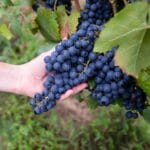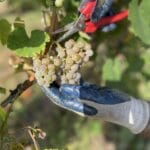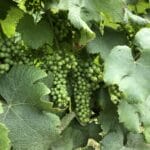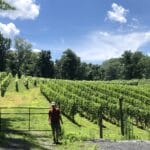Creating wine with these cleaner methods means one very significant thing, YOU MUST HAVE HIGH QUALITY FRUIT.
Arterra Wines has long since embraced the idea of True Terrior. So what does this really mean? At Arterra, we utilize minimal interventions in the cellar. This includes all Native Yeast Fermentations (we will discuss this significance of this in another post), no additives or chemicals, minimal sulfites and neutral oak. Creating wine with these cleaner methods means one very significant thing, YOU MUST HAVE HIGH QUALITY FRUIT. Having the best fruit is the pillar of creating a true terrior wine. The grapes will tell the narrative of how each vintage year evolved. Terrior is not just soil and earth, terrior as a philosophy is the story of growing the grapes. This not only includes overall land topography (slope), but also the people who tended the fruit, what chemicals were used (or in our case not used), how much the sun was shining, how much it rained or didn’t rain, how hot or humid, how cool and when; and YES, the natural yeast that grow on the skins of the fruit are all part of true terrior. Embracing all of these aspects and steering them to grow high quality fruit is just as much science as art.


Some parts of the world are easier places to grow winegrapes, but that doesn’t necessarily translate to better wine. Some places certainly present more challenges. Why would one choose to produce wine in a challenging region, how would they go about doing that compared to other regions, and what are the implications? As the saying goes: “Good things don’t come easy.” In fact – some of the worlds most interesting wines arise form these “challenging” regions. To explore this, let’s start broader and work our focus towards finer points….
Defining Virginia’s Climate in terms of Viticulture…..
Virginia is unique in several ways. Starting macro and then narrowing the view:
1) Virginia has Hot Summers, and Cold Winters. This is a conundrum – as most grapes that can handle our winters, do not perform well in heat; whereas most grapes that can handle our heat, do not survive our winters. Good choices become important to balance reliable productivity with optimal quality…..
2) As a viticulture ripening region – focusing on the influence of diurnal temperature regimes – Virginia can be defined as a region with Warm Days and Warm Nights during the growing and ripening season. This differs from most wine regions being coastal having cool nights accompanying the warm days (eg. Coastal California), or Cool Days with Cool Nights (think Finger Lakes, Bordeaux, Loire…). The warm nights rapidly reduce acidity during ripening. So while a grape like Petit Verdot or Tannat would be way too acidic in a region with cool nights, they come into an ideal balance in Virginia, and this is unique. So while some grapes handle #1 above as far as surviving and ripening – #2 here dramatically shortens the list in terms of consistent quality.


3) Virginia has Significant Rainfall. Some grapevines during ripening will continue to uptake as much water as is available to them – examples being Cabernet Sauvignon and Cabernet Franc. Whereas others have environmental cues that the season is ending and cease water uptake, initiating berry dehydration, which provides consistent concentration regardless of wet soils. This makes the list of ideal varietals quite small at this point.
4) And last Virginia has humidity and retains Damp Conditions in the canopy and on the fruit; another list shortening implication of which grapes are suitable.
Wow that is a big bad scary list of hardships, so why do it? Yet somehow, with Appalachian soils, shifts towards cooler fall ripening (as opposed to picking in summer heat), and unique varietals – Virginia produces some of the most genuinely flavorful wines in the world, in terms of fruit flavor characteristics.
So: step 1 – we’ve chosen some grapes that can handle the winters and shut down water uptake during late stages of ripening. Or did we? The site determines some of this…. The picture becomes subtly more complex…
Elevations & Soil/Water Relations:
Elevation Matters. There is a double edged sword of too low and too high in Virginia, with a sweet spot between. Recalling your high school physics class: as something cools converts from a gas to a liquid to a solid. Based on this, cooler air is technically denser, and settles to the low ground. This low ground is expansive, it is MOST of the land actually. This low ground has frost and winter kill problems. The warm air sits above it, on a mountainSIDE for example. But then there is an elevation at which the atmosphere takes over and temperatures drop with increasing elevation. In our area the warm band is 750 feet to 1100 feet. This is where the greatest number of grape varietals can be grown, while lower/higher sites may result in mortality. What to do if you are in the danger zone? -> shift towards hybrids and American varietals.
But this elevation dynamic is being expressed in relation to Virginia. Whereas, in a HOT region like much of Spain, the optimum sites are the lower valley floors that collect the cool air. Everything changes depending on where you are. Different regions require very different approaches.


Soils & Water: or should I say Slopes and Rocks. In Virginia we need to mitigate rainfall, and we find that we produce the highest quality grapes when grown on slopes, so that water can both run off the soil, and run laterally downhill within the soil. Furthermore we tend to plant our rows going down the slope, so that there are no rows of roots acting as a dam to inhibit the flow of water off the site. Flat sites in Virginia retain far too much water. Whereas in a dry dry region (Spain again) these flat sites may be preferred to capture every drop of rain and retain it, internationally planting across slopes to stop water flow, and terracing to maximize the benefit. Rocks – simply result in less soil. Less soils is less nutrition and less water – ideal for us here in Virginia, maybe not elsewhere.
Once we’ve chosen the right vines, and how to plant them, then we need to adapt our Growing Philosophies. Many regions can minimally manage a vine, whether mechanized or by hand, and obtain large yields from fertile soils, with little disease in an arid climate. In the mid-atlantic, a great amount of effort goes into thinning the density of the canes/shoots, and maintaining the separation of canes & clusters. Anything stacked, layered, or piled, in Virginia will surely develop disease in the canopy and fruit. We need to have conditions that allow the vine to dry as quickly as possible after rain or dew – meaning air movement, sunlight, and as needed spray coverage. The upside here is with a properly maintained canopy, much fewer sprays are needed, with far softer materials, especially as the season progresses.
In Sum…
Upon embracing the factors that define Virginia, quality arises. Connect the right grape varietal, with a good site, and proper management -> and we’re well on our way to Consistent Quality. The proof of these vineyard aspects being properly tended to, is the ability to produce a consistently high wine WITH truly Minimalist and Clean cellar practices. After all, if the winemaker isn’t going to “fix” it in the cellar, then the quality of the grapes is the one defining factor in the quality of the wine.
